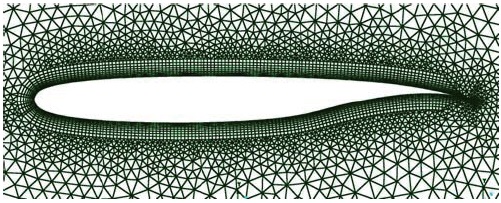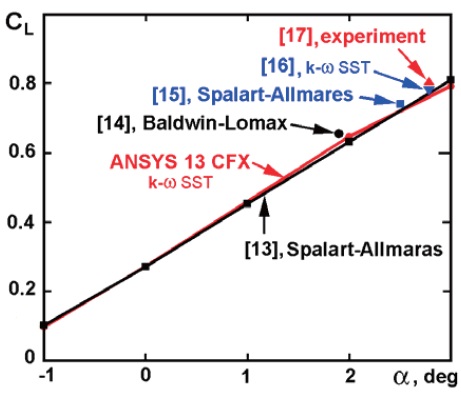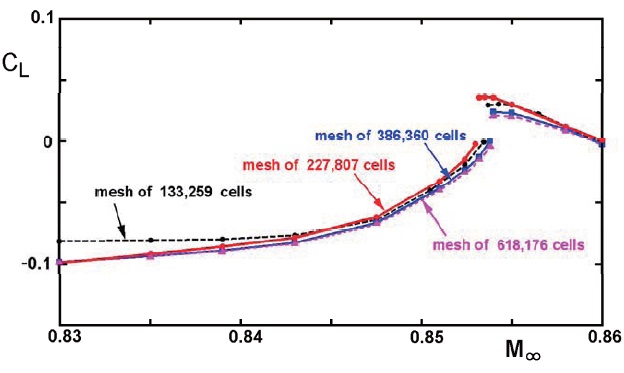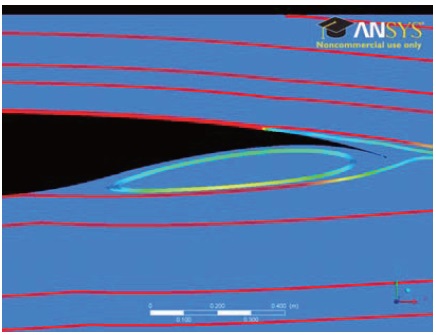



The sensitivity of transonic flow past a Whitcomb airfoil to deflections of an aileron is studied at free-stream Mach numbers from 0.81 to 0.86 and vanishing or negative angles of attack. Solutions of the Reynolds-averaged Navier-Stokes equations are obtained with a finite-volume solver using the k-ω SST turbulence model. The numerical study demonstrates the existence of narrow bands of the Mach number and aileron deflection angles that admit abrupt changes of the lift coefficient at small perturbations. In addition, computations reveal free-stream conditions in which the lift coefficient is independent of aileron deflections of up to 5 degrees. The anomalous behavior of the lift is explained by interplay of local supersonic regions on the airfoil. Both stationary and impulse changes of the aileron position are considered.
The correct prediction of the effectiveness of wing control surfaces (ailerons and spoilers) is of major importance in the process of aircraft design. The development of numerical methods enables accurate simulation of transonic flow over control surfaces with fixed deflection angles [1,2]. A number of studies examined transonic flow over time-dependent flaps, as well as aeroelastic behavior of airfoils and wings [3-5]. However, the flow sensitivity to small perturbations in various bands of the angle of attack and Mach number has not been subject to detailed analysis.
The upward deployment of an aileron or spoiler flattens the profile in the vicinity of the aileron-airfoil juncture or even makes it locally concave. In the 2000s, a number of numerical studies demonstrated a high sensitivity of transonic flow to variations of free-stream parameters when the airfoil comprises a flat or nearly flat arc. The sensitivity is caused by the interaction of two supersonic regions that arise and expand on the arc as the free-stream Mach number increases. The expansion followed by a coalescence of the supersonic regions crucially changes pressure distributions and aerodynamic loads on the airfoil. This phenomenon was scrutinized for a number of symmetric profiles [6-7], as well as for the asymmetric J-78 airfoil whose upper surface is nearly flat in the midchord region [6,8]. Also the instability of closely spaced supersonic regions was examined for a Whitcomb airfoil with a deflected aileron at the Reynolds number Re=5.6×106 [9].
In this paper, we study transonic flow past a Whitcomb airfoil with aileron deflections at the vanishing or negative angles of attack, which are typical for a descending flight of civil and transport aircraft, at Re=1.4×107. The emphasis is laid on the flow physics and free-stream conditions that admit anomalous behavior of the lift coefficient.
We consider a fully turbulent 2D flow past an airfoil given by the expressions
where
On the inflow part Γ1 of the boundary, we prescribe stationary values of the angle of attack α, free-stream Mach number M∞?1, and static temperature
Solutions of the RANS equations were obtained with the ANSYS 13 CFX finite-volume solver based on a highresolution discretization scheme for convective terms [11]. We employed an implicit second-order accurate backward Euler scheme for the time-stepping. Computations were performed on hybrid unstructured meshes of about 4×105 cells, which were clustered in the boundary layer, in the
wake, and in the vicinities of the shock waves. The nondimensional thickness y+ of the first mesh layer on the airfoil was less than 1 (see Fig. 2). We used the standard
The solver was verified by computation of solutions for a few benchmark problems and comparison with experimental and numerical data available in the literature. Figure 3 shows good agreement of the lift coefficient
In the case of stationary boundary conditions, steadystate solutions were obtained by the global time-stepping in 2 to 6 seconds. The solutions yield a flow field, as well as aerodynamic forces on the airfoil. This makes it possible to calculate the lift coefficient
386,360 cells provides a good accuracy of the solution.
Figure 5 illustrates the obtained dependence of the lift coefficient
At the same time Figs. 5a and 5b show that, when M∞?0.855, the lift coefficient is independent of aileron deflections up to 5 and 4 degrees, respectively. This can be explained again by the interplay of local supersonic regions. Indeed, Figure 6 shows that at θ=0 the airfoil’s trailing edge resides in a stagnation zone above the streamline separated from the lower surface of the airfoil. That is why moderate upward deflections of the aileron do not influence the flow field. With increasing aileron deflection angle from 0 to 4 deg, the supersonic regions slightly expand on both surfaces (see Fig. 7), that is why the lift coefficient persists. If the angle θ further increases, then the supersonic region on the upper surface shrinks, while that on the lower surface expands. As a consequence, the static pressure drops on the lower surface, and the lift coefficient drops.
Also we considered a time-dependent aileron deflection θ(
For the airfoil at hand, there exist adverse free-stream conditions that admit abrupt changes of the lift coefficient at small variations of the aileron deflection angle. Conversely, there exist conditions in which a response of the lift coefficient to aileron deflections is anomalously weak, so that the aileron fails to control the lift. Both anomalous phenomena are caused by the interplay of local supersonic regions on the airfoil.







